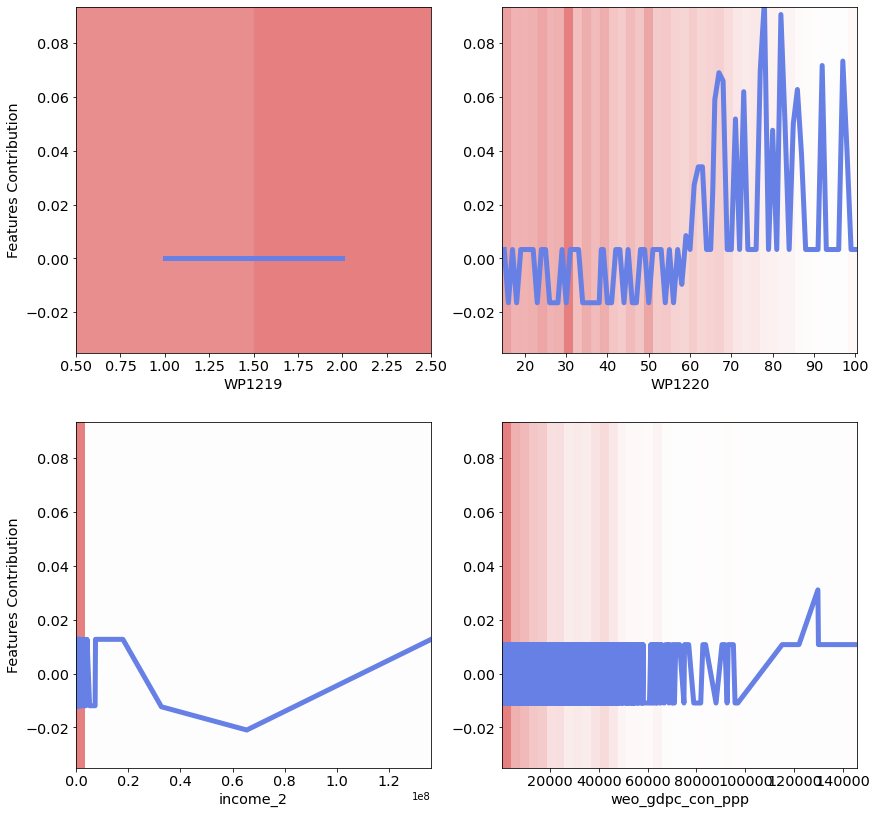Overview | Installation | Paper
NAM is a library for generalized additive models research. Neural Additive Models (NAMs) combine some of the expressivity of DNNs with the inherent intelligibility of generalized additive models. NAMs learn a linear combination of neural networks that each attend to a single input feature. These networks are trained jointly and can learn arbitrarily complex relationships between their input feature and the output.
from nam.config import defaults
from nam.data import FoldedDataset, NAMDataset
from nam.models import NAM, get_num_units
from nam.trainer import LitNAM
from nam.utils import *config = defaults()
print(config)>> Config(activation='exu', batch_size=1024, cross_val=False, data_path='data/GALLUP.csv', decay_rate=0.995, device='cpu', dropout=0.5, early_stopping_patience=50, experiment_name='NAM', feature_dropout=0.5, fold_num=1, hidden_sizes=[64, 32], l2_regularization=0.5, logdir='output', lr=0.0003, num_basis_functions=1000, num_epochs=1, num_folds=5, num_models=1, num_splits=3, num_workers=16, optimizer='adam', output_regularization=0.5, regression=False, save_model_frequency=2, save_top_k=3, seed=2021, shuffle=True, units_multiplier=2, use_dnn=False, wandb=True)import sklearn
housing = sklearn.datasets.fetch_california_housing()
dataset = pd.DataFrame(data=housing.data, columns=housing.feature_names)
dataset['target'] = housing.target
config.regression = True
dataset = NAMDataset(config,
data_path=dataset,
features_columns=dataset.columns[:-1],
targets_column=dataset.columns[-1])
## Getting the training dataloaders
dataloaders = dataset.train_dataloaders()model = NAM(
config=config,
name="NAM_GALLUP",
num_inputs=len(dataset[0][0]),
num_units=get_num_units(config, dataset.features),
)
model>>> NAM(
(feature_nns): ModuleList(
(0): FeatureNN(
(model): ModuleList(
(0): ExU(in_features=1, out_features=1000)
(1): LinReLU(in_features=1000, out_features=64)
(2): LinReLU(in_features=64, out_features=32)
(3): Linear(in_features=32, out_features=1, bias=True)
)
)
(1): FeatureNN(
(model): ModuleList(
(0): ExU(in_features=1, out_features=4)
(1): LinReLU(in_features=4, out_features=64)
(2): LinReLU(in_features=64, out_features=32)
(3): Linear(in_features=32, out_features=1, bias=True)
)
)
(2): FeatureNN(
(model): ModuleList(
(0): ExU(in_features=1, out_features=184)
(1): LinReLU(in_features=184, out_features=64)
(2): LinReLU(in_features=64, out_features=32)
(3): Linear(in_features=32, out_features=1, bias=True)
)
)
)
)for fold, (trainloader, valloader) in enumerate(dataloaders):
tb_logger = TensorBoardLogger(save_dir=config.logdir,
name=f'{model.name}',
version=f'fold_{fold + 1}')
checkpoint_callback = ModelCheckpoint(filename=tb_logger.log_dir +
"/{epoch:02d}-{val_loss:.4f}",
monitor='val_loss',
save_top_k=config.save_top_k,
mode='min')
litmodel = LitNAM(config, model)
trainer = pl.Trainer(logger=tb_logger,
max_epochs=config.num_epochs,
checkpoint_callback=checkpoint_callback)
trainer.fit(litmodel,
train_dataloader=trainloader,
val_dataloaders=valloader)
## Testing the trained model
trainer.test(test_dataloaders=dataset.test_dataloaders())
## Output
>>> [{'test_loss': 236.77108764648438,
'test_loss_epoch': 237.080322265625,
'Accuracy_metric_epoch': 0.6506563425064087,
'Accuracy_metric': 0.6458333134651184}]fig1 = plot_mean_feature_importance(litmodel.model, dataset)
fig2 = plot_nams(litmodel.model, dataset, num_cols= 3)
$ python main.py -h
usage: Neural Additive Models [-h] [--num_epochs NUM_EPOCHS]
[--learning_rate LEARNING_RATE]
[--batch_size BATCH_SIZE] --data_path DATA_PATH
--features_columns FEATURES_COLUMNS
[FEATURES_COLUMNS ...] --targets_column
TARGETS_COLUMN [TARGETS_COLUMN ...]
[--weights_column WEIGHTS_COLUMN]
[--experiment_name EXPERIMENT_NAME]
[--regression REGRESSION] [--logdir LOGDIR]
[--wandb WANDB]
[--hidden_sizes HIDDEN_SIZES [HIDDEN_SIZES ...]]
[--activation {exu,relu}] [--dropout DROPOUT]
[--feature_dropout FEATURE_DROPOUT]
[--decay_rate DECAY_RATE]
[--l2_regularization L2_REGULARIZATION]
[--output_regularization OUTPUT_REGULARIZATION]
[--dataset_name DATASET_NAME] [--seed SEED]
[--num_basis_functions NUM_BASIS_FUNCTIONS]
[--units_multiplier UNITS_MULTIPLIER]
[--shuffle SHUFFLE] [--cross_val CROSS_VAL]
[--num_folds NUM_FOLDS]
[--num_splits NUM_SPLITS] [--fold_num FOLD_NUM]
[--num_models NUM_MODELS]
[--early_stopping_patience EARLY_STOPPING_PATIENCE]
[--use_dnn USE_DNN] [--save_top_k SAVE_TOP_K]
optional arguments:
-h, --help show this help message and exit
--num_epochs NUM_EPOCHS
The number of epochs to run training for.
--learning_rate LEARNING_RATE
Hyperparameter: learning rate.
--batch_size BATCH_SIZE
Hyperparameter: batch size.
--data_path DATA_PATH
The path for the training data
--features_columns FEATURES_COLUMNS [FEATURES_COLUMNS ...]
Name of the feature columns in the dataset
--targets_column TARGETS_COLUMN [TARGETS_COLUMN ...]
Name of the target column in the dataset
--weights_column WEIGHTS_COLUMN
Name of the weights column in the dataset
--experiment_name EXPERIMENT_NAME
The name for the experiment
--regression REGRESSION
Boolean flag indicating whether we are solving a
regression task or a classification task.
--logdir LOGDIR Path to dir where to store summaries.
--wandb WANDB Using wandb for experiments tracking and logging
--hidden_sizes HIDDEN_SIZES [HIDDEN_SIZES ...]
Feature Neural Net hidden sizes
--activation {exu,relu}
Activation function to used in the hidden layer.
Possible options: (1) relu, (2) exu
--dropout DROPOUT Hyperparameter: Dropout rate
--feature_dropout FEATURE_DROPOUT
Hyperparameter: Prob. with which features are dropped
--decay_rate DECAY_RATE
Hyperparameter: Optimizer decay rate
--l2_regularization L2_REGULARIZATION
Hyperparameter: l2 weight decay
--output_regularization OUTPUT_REGULARIZATION
Hyperparameter: feature reg
--dataset_name DATASET_NAME
Name of the dataset to load for training.
--seed SEED seed for torch
--num_basis_functions NUM_BASIS_FUNCTIONS
Number of basis functions to use in a FeatureNN for a
real-valued feature.
--units_multiplier UNITS_MULTIPLIER
Number of basis functions for a categorical feature
--shuffle SHUFFLE Shuffle the training data
--cross_val CROSS_VAL
Boolean flag indicating whether to perform cross
validation or not.
--num_folds NUM_FOLDS
Number of N folds
--num_splits NUM_SPLITS
Number of data splits to use
--fold_num FOLD_NUM Index of the fold to be used
--num_models NUM_MODELS
the number of models to train.
--early_stopping_patience EARLY_STOPPING_PATIENCE
Early stopping epochs
--use_dnn USE_DNN Deep NN baseline.
--save_top_k SAVE_TOP_K
Indicates the maximum number of recent checkpoint
files to keep.@misc{kayid2020nams,
title={Neural additive models Library},
author={Kayid, Amr and Frosst, Nicholas and Hinton, Geoffrey E},
year={2020}
}@article{agarwal2020neural,
title={Neural additive models: Interpretable machine learning with neural nets},
author={Agarwal, Rishabh and Frosst, Nicholas and Zhang, Xuezhou and Caruana, Rich and Hinton, Geoffrey E},
journal={arXiv preprint arXiv:2004.13912},
year={2020}
}


